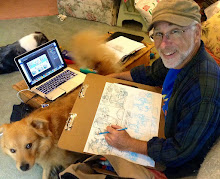 |
| "korumbu! confesses" by geoff grogan; from pood #3. |
My wife often tells me that I don't make comics. "You do something else-but it isn't comics" She'll point to some book or another on my shelves-more likely than not something by Jack Kirby or Gilbert Hernandez or Seth or Chester Gould or,or, or.... -and very confidently state: "This is comics. Look at what you do. You don't do that."
Then she'll say-that "...if you want to make comics you should just make comics..."---implying that I should stop screwing around with this other stuff and get back to telling a story with boxes and word balloons. "A comics audience won't be interested in this work because its not comics. Its something else--like painting."
 |
| "secret romance" by geoff grogan; from pood #2. |
These "stops" in the composition--should move the reader around the page--but not necessarily in a defined-a to b to c -style sequence, but like painting---in more random fashion, determined by the viewer's eye- so that there's no real beginning-and no real end.
This isn't to imply the piece lacks "meaning"-but rather that meaning is elicited via the methods of visual art, suggestion and association, rather than in the more direct fashion of traditional narrative structures.
"See what I mean? not comics!" she says. "and you're not drawing either. What's with the collage?"
 |
| "fandancer" by geoff grogan; page 26 |
Collage introduces a level of conceptual distance and unpredictability--and works to undermine traditional narrative - opening the story up to a wide array of suggestions and ideas-many of which I never would have conceived of had I been writing in a traditional
way. In fandancer, the "narrative" actually percolates beneath the surface incongruities and absurdities, providing subliminal continuity but allowing myriad interpretations and associations that move the piece in multiple directions at once.
Obviously, I'm not a big believer in rock-solid "do's and don'ts"-- in comics --or in art, for that matter. There are many roads to the destination--and even then, not everyone is interested in going to the same place.
 |
| "fandancer" by geoff grogan; page 27 |
 |
| "fandancer" by geoff grogan; page 28 |
Comics? Not comics? It only matters in so far as it means someone will (or won't) pick up the book and take it home.
*(and despite periodically playing devil's advocate, my wife deb is actually the biggest, best supporter anyone could have--and the most likely to say"stick to your guns! you've gotta do what you've gotta do-otherwise, what's the point?" hell, she's only stuck it out for 25 years! thanks, love!)

